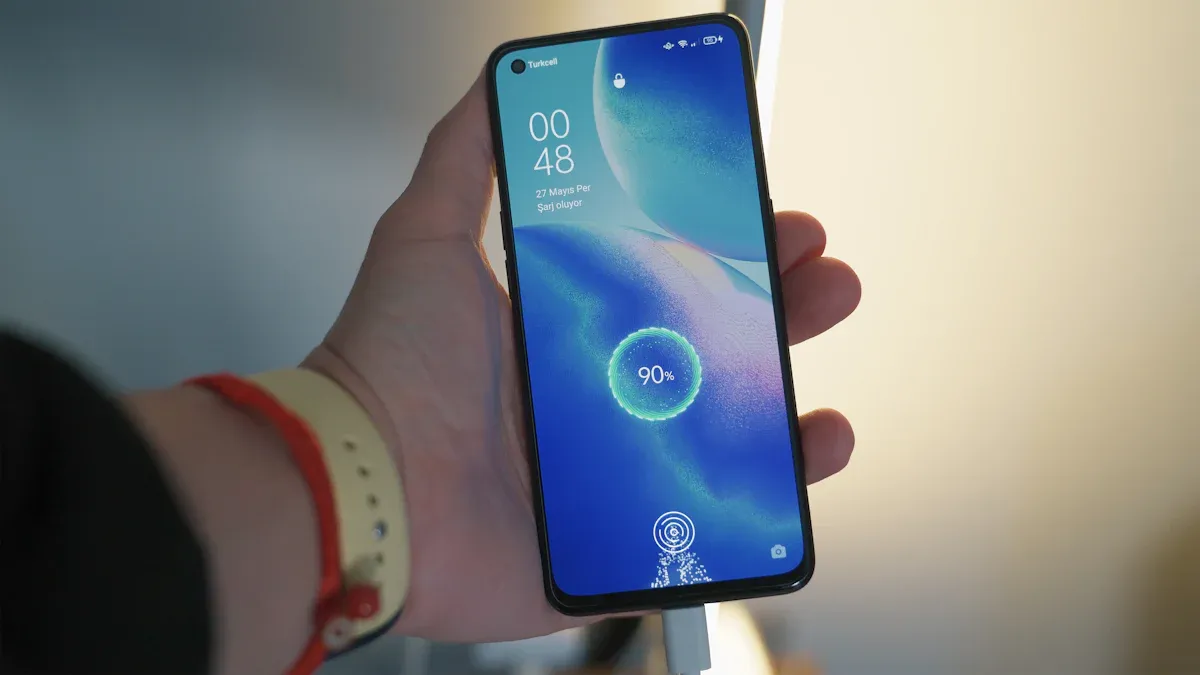

Advanced communication protocols including robust BMS communication
Top companies build systems that can grow. They use backup protocols and quick problem checks to make things safer and easier to connect through effective BMS communication. The wireless BMS market will grow fast. This is because more people use electric cars and smart grids. These features help battery systems last longer. They let people watch and use energy well. People should look for these key things when picking BMS products.
Pick BMS products that use strong communication protocols like CAN Bus and Modbus. These help share data quickly, safely, and over long distances.
Wireless and remote monitoring with Bluetooth and BLE let you check battery health right away. This makes things safer and saves energy.
Modular and scalable BMS designs let you add or swap battery parts easily. You do not need to turn off the system. This makes fixing things easier.
Ultra-low power communication modes help batteries last longer and use less energy. This helps systems work better and for more time.
Choose BMS systems that use open protocols and security features. This keeps energy management safe, flexible, and ready for the future.

Battery management systems use different communication protocols. These help keep things safe and working well. Some protocols are used more than others in big battery systems.
CAN Bus is used a lot in cars and factories. It is very reliable. It sends data fast and does not get messed up by electrical noise. Many devices can talk to each other at the same time with CAN Bus.
Modbus (RTU/ASCII/TCP) is common in factories and energy systems. It uses a master-slave setup. This makes it simple and easy to connect with controllers. Modbus RTU works over RS-485 for long distances. Modbus TCP/IP uses Ethernet for faster speeds and smart grid use.
RS-485 helps send data far, which is good for big setups. It is often used with Modbus in battery systems with high voltage.
SPI, I2C, UART are found in smaller or built-in systems. They work well for small devices. These are not used much in big battery management systems.
Protocol | Typical Speed | Typical Range | Common Applications |
|---|---|---|---|
CAN Bus | ~40 meters | Automotive, Industrial BMS | |
Modbus RTU/RS-485 | Up to 10 Mbps | Up to 1200 meters | Industrial automation, renewable energy, BMS |
RS-485 | Up to 10 Mbps | Up to 1200 meters | Industrial control, long-distance BMS |
Note: CAN Bus is great for sending data fast and staying strong. Modbus and RS-485 are good for being flexible and working over long distances.
Interoperability means different parts can work together. It helps battery systems connect with controllers and chargers. Using open protocols like Modbus, BACnet, and OPC lets devices share data easily. Gateways or middleware can change data between protocols. This makes it easier to connect everything.
Protocol checks show what standards a system uses, like MQTT or API connections.
Edge gateways and IoT hubs bring data together from many places. This keeps information the same everywhere.
Secure API gateways and message queuing like MQTT keep data safe. They also help send updates right away.
Protocol converters and special connectors let old systems work with new battery management parts. This stops data from getting stuck in one place.
Rules from governments also affect which protocols are used. For example, U.S. cybersecurity and European privacy laws need safe and open ways to talk. Companies must follow these rules to avoid problems and get their systems approved.
Problems with interoperability happen when protocols do not match or software does not work together. Using open standards and designs that can change helps battery management systems work in the future and saves money on connecting things.

Modern battery management systems use wireless modules like Bluetooth and BLE. These let people check battery status without wires. BLE uses little power and collects data from sensors in real time. Sensors can measure things like temperature, voltage, and if someone is in a room. This helps building systems like lights and HVAC react fast to changes. It saves energy and makes people more comfortable.
BLE works well with smart BMS platforms.
People can check battery health from far away using apps or the cloud.
Smart BMS modules send alerts if batteries get too hot or lose power. This keeps things safe and working well.
Data logs and analysis help fix problems before they get worse.
BLE sensors notice when rooms are empty, so systems use less energy.
More than 70% of new BMS products in 2025 will have wireless or remote monitoring. Top companies and battery makers now focus on wireless BMS with strong security.
Security is very important for wireless BMS communication. Bluetooth and BLE can have problems like people listening in or remote attacks. To keep data safe, systems use special passwords and extra security tools. These steps help protect battery data and make it trustworthy.
Real-time data access changes how backup and off-grid power systems work. Cloud-based smart BMS gives instant updates about battery health and how well it works. This helps people know the state of charge and health better. It makes batteries last longer and work better.
Real-time monitoring finds problems early and stops failures.
Better thermal management and cell balancing protect batteries.
Cloud computing helps with smart analysis and machine learning.
People can see live data and fix issues fast, saving time and money.
Real-time data in BMS helps find problems early. This keeps equipment working longer and lowers repair costs.
Wireless and remote monitoring are important for the future of BMS communication. These features make battery systems safer, easier to use, and better for remote places.
Modern battery management systems need to grow with energy needs. BMS communication interfaces now let designs change and expand easily. These systems use modular and decentralized setups. Each battery module has its own unit to watch over it. These units talk to each other using networks like RS-485 or CAN bus. The master controller collects data from every module and runs the whole system.
A modular setup lets you add or remove battery cells and modules easily. Technicians can upgrade or swap parts without turning off the system. This design also makes wiring simpler and helps the system handle problems better. If one module breaks, the rest still works. Short wires between cells and monitoring units help measure things better and lower noise.
Aspect | Explanation |
|---|---|
Cells and modules can be added or removed easily without system shutdown. | |
Flexibility | Supports different battery modules and adapts to various layouts and environments. |
Fault Tolerance | Modular design avoids single points of failure. |
Wiring Complexity | Localized sensing and modular connections reduce wiring. |
Maintenance | Easier modular replacement and fault isolation. |
Distributed and modular BMS setups use real-time data sharing. This helps control and keep big energy storage safe. Communication networks must find problems fast and keep things running safely.
Saving energy is very important for battery management. Ultra-low power communication modes like Bluetooth Low Energy (BLE) 5.0 help use less power. These modes send data faster and use smaller packets. Because of this, the BMS can lower power use for communication by up to half. This makes batteries last longer and need charging less often.
Many BMS designs use deep sleep modes. Devices wake up only when needed, do their job, then go back to sleep. This lets some wireless sensor networks work for years on one battery. In wearable electronics, smart BLE communication lets devices run for days without charging.
Power Saving Mode | Description | Power Consumption (mW) | Latency (ms) |
|---|---|---|---|
Deep sleep when not transmitting/receiving | 0.1 – 1 | 2 – 10 | |
eDRX | Extends sleep duration to reduce power | 1 – 10 | 50 – 1000 |
RAI | Releases radio resources after transmission | 5 – 50 | 10 – 100 |
Ultra-low power communication modes help systems run almost forever when used with energy harvesting. This makes BMS communication better and more dependable for future energy systems.
Picking the best battery management system means looking at how it talks to other devices. Top BMS products can use many protocols like CAN, UART, and RS485. This makes it simple to connect with controllers, chargers, and monitors. Newer systems often have wireless choices like BLE or Zigbee. These wireless options cut down on wires and make it easier to add more parts. The hardware should have strong PCBs that can handle heat and electricity, even in tough places.
A modular setup lets people change and grow the system for different needs. Over-the-air updates let you fix and upgrade the system from far away. This saves money on repairs. Meeting rules like UL, ISO26262, CE, and UN38.3 means the system is safe and trusted. When checking protocol support, make sure the BMS can read and share all the needed data. It should work with both open and special protocols for future changes.
Real-life problems, like the Arizona McMicken battery blast and fires in South Korea’s ESS, show that bad BMS communication can cause safety issues and money loss. Better communication features help stop these problems.
Experts say to follow some steps for a good BMS setup:
Pick BMS platforms that use open protocols like BACnet or Modbus for better teamwork.
For old systems, try wireless sensors to use fewer wires.
Work with skilled vendors or system helpers.
Use tools to check if all equipment fits together.
Test and check all communication features after setting up.
Keeping things safe is very important. Teams should use codes to lock data, safe remote access, and update software often. Training users and workers helps the system work better. BMS systems that can grow will work with new tech and data rules. Features like fixing problems from far away and smart AI tools make the system even more reliable and efficient.
In off-grid and mixed systems, better BMS communication keeps batteries safe from quick damage and saves money on running costs.
Battery management systems in 2025 need to have advanced protocols, wireless monitoring, and smart integration. These features help check batteries in real time. They also make it easy to add more parts and keep things safe. The table below shows how each feature helps battery systems get ready for the future. These features let systems change, work well, and keep data safe.
Feature | Future-Proofing Role |
|---|---|
Wired/Wireless Comm. | Real-time monitoring, adaptability |
Galvanic Isolation | Safety, fault tolerance |
Robust Protocols | Scalability, secure integration |
Picking BMS products with these features makes energy systems safer, smarter, and last longer.
CAN Bus is the main protocol for electric vehicles. It moves data quickly and is very reliable. Car engineers use CAN Bus to keep batteries safe and working well.
Wireless monitoring gives alerts right away about battery heat or voltage. Technicians can find problems fast. This helps stop overheating and lowers fire risk.
Many BMS systems have protocol converters. These let new controllers link to old battery modules. This helps companies upgrade without changing every part.
Modular integration means technicians can add or take out battery cells easily. Each module works on its own. This makes fixing things simple and keeps the system running if one part breaks.